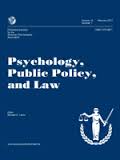 Consideration of cultural context is important for the evaluation of risk for violence in Australian Aboriginal Offenders and, by extension, other cultural minority groups. This is the bottom line of a recently published article in Psychology, Public Policy, and Law. Below is a summary of the research and findings as well as a translation of this research into practice.
Consideration of cultural context is important for the evaluation of risk for violence in Australian Aboriginal Offenders and, by extension, other cultural minority groups. This is the bottom line of a recently published article in Psychology, Public Policy, and Law. Below is a summary of the research and findings as well as a translation of this research into practice.
Featured Article | Psychology, Public Policy, and Law | 2014, Vol. 20, No. 3, 281-293
Violence Risk Assessment in Australian Aboriginal Offender Populations: A Review of the Literature
Author
Abstract
The utilization of violence risk instruments in forensic populations is increasing and a plethora of empirical investigations support their ability to predict recidivistic outcomes. However, the generalizability of these findings to culturally diverse populations is problematic given dissimilarities in cultural traditions, norms, and experiences. The present study explored this subject in relation to Aboriginal Australians. First, a concert of violence risk markers that are more prevalent among Aboriginal Australian offenders compared with non-Aboriginal offenders were examined in light of their social and historical context. Next, studies employing violence risk instruments on cohorts of Aboriginal Australian offenders were reviewed. Findings demonstrated moderate predictive accuracy for violence and commensurate utility with non-Aboriginal offenders although results should be treated with caution due to the paucity of available studies for consideration. Implications for clinical practice and culturally appropriate assessment models are discussed.
Keywords
risk assessment, Aboriginal Australians, risk factors for violence, forensic psychology, clinical psychology
Summary of the Research
“The assumption that risk factors for violent and general recidivism extend to all offenders has been described as ethnocentric and engenders the misclassification of minority offenders potentially impacting their ability to receive adequate treatment… Contrastingly, prior research has demonstrated the commonalities of maladaptive behaviors across culturally diverse groups suggesting the universal utility of particular standardized risk measures. This debate has materialized in Australian clinical literature in light of the overrepresentation of Aboriginal and/or Torres Strait Islander Australians that are processed through the criminal justice system. Aboriginal and Torres Strait Islander peoples represent 2.5% of the overall Australian population yet comprise 27% and 53% of adults and juveniles in custody, respectively. Research indicates that both adult and juvenile Aboriginal offenders are more likely to receive a custodial sentence and to have had previous contact with law enforcement compared to non-Aboriginal offenders” (p. 281).
“Prior investigations have underscored the higher rates of substance misuse, psychological distress, exposure to traumatic events, physical health problems, and contact with child protection agencies of Aboriginal Australians compared with non-Aboriginal Australians” (p. 282).
“Given the history of disenfranchisement and over-representation of Aboriginal people in Australia’s criminal justice system for violence related offenses, it is important that violence risk assessment instruments are validated as culturally appropriate for use with Aboriginal offenders to avert further inequity. The development of culturally relevant assessments potentially enables a consideration of the effects of historical and ongoing injustices on the contemporary wellbeing of Indigenous clients, thus engendering increased access to services and appropriate interventions for Aboriginal people.
In order to demonstrate utility with an Aboriginal offender population, risk measures must accomplish two objectives. First, it is important to ensure that the antecedent risk markers contained in risk checklists are equally valid for Aboriginal offender populations. Second, the administering of such instruments must be conducted within a culturally sensitive framework by a culturally competent and responsible practitioner” (p. 282).
The authors review the available literature on risk markers and risk assessment instruments with Australian Aboriginal offender groups and make recommendations regarding the importance of using a culturally sensitive framework for risk assessment with minority groups.
Risk Factors for Violence Among Australian Aboriginal Offenders
A review of the available literature indicates that there are several “risk factors common to violent offenders that have been found to have a greater prevalence among Australian Aboriginal offenders compared with non-Aboriginal offenders (p. 283).”
The risk factors that have a greater prevalence in Aboriginal offenders include:
-
Offending History/Early Offense Initiation
“Australian Aboriginal offenders have been found more likely than non-Aboriginal offenders to have served preceding periods in detention. Adult Aboriginal offenders are also more likely to have a history of juvenile detention…Prior offending history and exposure to violence appear to be considerable indicators of future recidivism for Aboriginal people. The overrepresentation of Aboriginal people in contemporary criminal justice data should also be considered within a historical context that comprised discriminatory and punitive policing practices.” (p. 283).
-
Education/Unemployment
“Reports indicate that higher proportions of the Aboriginal population use illicit drugs compared with the non-Aboriginal population. In addition, the high prevalence of illicit drug use in Aboriginal correctional populations has been observed…Other studies on Aboriginal prisoners in Australia have discovered early exposure to substance abuse and a greater likelihood of being under the influence at arrest or in the course of a primary offense” (p. 283).
-
Mental Health
“Associations between mental illness and violent offending have been demonstrated in the literature and higher rates of mental health illnesses/issues are detected in offender samples within both Aboriginal and non-Aboriginal populations compared with the general community. The presence of a mental illness has been found to increase the likelihood of recidivism for juvenile and adult offenders and incidentally shorten the return time to prison. Extant research has indicated high rates of mental illness among the general Aboriginal population…Of greater concern are findings that indicate Aboriginal offenders are far less likely to have received previous mental health treatment than non-Aboriginal offenders” (p. 284).
-
Family Violence
“Despite government initiatives to address the issue of family and lateral violence in Aboriginal communities, more than a third of Aboriginal prisoners are sentenced for intentional acts to cause injury (ABS, 2013). Given the prevalence of serious family related violence across portions of the Aboriginal population (Cripps & Adams, 2014), the likelihood of young Aboriginal people engaging in future violent behavior is subsequently escalated” (p. 284).
“The article [also] found that although incipient research has largely demonstrated comparative predictive ability for particular risk inventories across Aboriginal and non-Aboriginal samples, further investigation, particularly in the Australian context is warranted. It is also important to note than for the bulk of these studies, Aboriginal participants presented with higher baseline scores than non-Aboriginal participants although the predictive ability of the instruments were largely similar. This raises questions around potential misdiagnosis or possible overclassification and requires further exploration” (p. 288).
Translating Research into Practice
“This [article] underscores the cross-cultural regularity of certain core risk factors for violence. However, the analysis also indicates that violence risk factors for Aboriginal Australians may have unique precursory origins, notably the disruption of social and emotional wellbeing. As such, a comprehensive violence risk assessment must be considered within a broader cultural context and with regard to enduring legacies of colonization” (p. 285).
“Cultural competence is a set of attitudes and process of engagement that facilitates cross-cultural assessment through the accommodation of the diverse set of cultural experiences and worldviews of the client. It is now widely acknowledged that cultural competence is fundamental to good assessment practice and involves a commitment by the practitioners to self-exploration, critical self-reflection, and recognition of the implications of the power differentials inherent in their role of clinicians. It is essential for practitioners to possess a greater understanding of Aboriginal experiences” (p. 287).
“[This is] particularly important in the context of undertaking appropriate assessments in the criminal justice system to ascertain the possible mental health issues that may be contributing to maladaptive behavior, antisociality, and perceived attitudes. Additionally, any approach should be imbedded within a holistic model and any intervention should reflect this model when developing/delivering programs relating to violence. Intervention models should also include a spiritual element to allow individuals to connect or reconnect to their culture, while also considering the social and economic factors that may increase the risk of offending. The responsivity principle within the Risk-Needs-Responsivity rehabilitation model facilitates the matching of treatment to an offender’s personal and cultural circumstances. The development of treatment and rehabilitation programs which encompass pertinent cultural aspects and customs enhance service delivery, as well as cultivating motivation and program engagement for Aboriginal clients. Emerging alternative ways forward for Aboriginal offenders now include culturally appropriate Cognitive Behavior Therapy programs and strategies and tools for healing and cultural recovery aimed at overcoming violence.
Given these advances it is crucial that cultural competence is exercised in any violence risk assessment and associated treatment rehabilitation plan. It is equally the case that the criminal justice system needs to be culturally responsive and that the police, respective courts and prisons function in a culturally sensitive manner to support the needs of both practitioner and offenders” (p. 287).
Other Interesting Tidbits for Researchers and Clinicians
“Future research should also aim to identify what risk factors differentiate Aboriginal offenders from the general Aboriginal population. Again, it is important that these risk items are considered in light of systematic racism and disadvantage, which are directly linked to the pervasive and enduing impacts of colonization” (p. 288).
Join the Discussion
As always, please join the discussion below if you have thoughts or comments to add!







